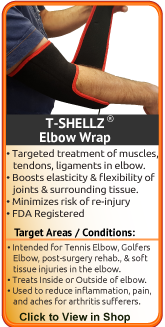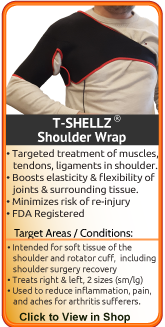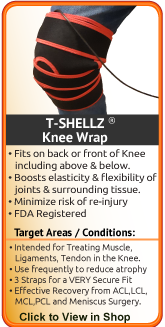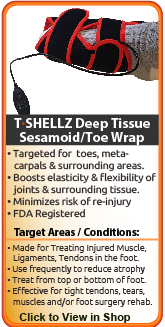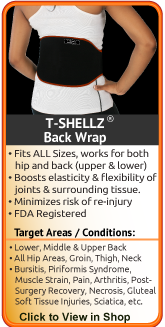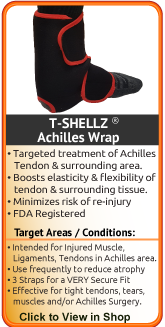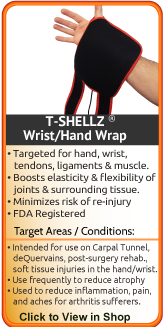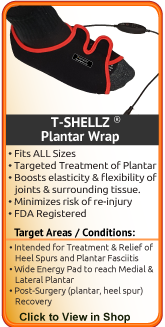Tendon Surgery and
Post-Operative Rehabilitation
So, you are experiencing a painful tendon injury that has persisted over some time and never seems to go away.
If your doctor has diagnosed the injury to be tendonitis and does not recommend surgery, he/she will most likely recommend a course of conservative treatments for at least six weeks before even suggesting surgery. It is generally understood by doctors and surgeons, that surgery will introduce more scar tissue into the already damaged soft tissue. This added scar tissue will be problematic, requiring more visits to your physical therapist (PT) and conservative treatment options post-surgery. If not dealt with properly, your tendon injury could end up in worse condition than before the surgery - and this is typically why surgery is only performed as a last resort.
If you are unsure about whether you need surgery on your tendon, you may want to read through our "Do I Need Surgery Page, here.
Most doctors, physicians and orthopedic specialists will recommend conservative treatments for minor tendon tears & injuries before considering surgery.
Some conservative treatment methods recommended include:
- Rest - This is important for initial healing to reduce pain, swelling and inflammation in the early stage of your soft tissue injury. Too much rest can also be harmful as joint immobility can actually cause stiffening, overcompensation and atrophy (wasting away of soft tissue). This is why rest should be used when reducing initial pain and swelling, but should not be considered for more long-term conservative treatment.
- Avoid Activity that caused your injury. - While resting the area, it's also important to avoid all activities that may have caused your symptoms - including any repetitive movements (possibly work or hobby related). This may include reduced activities in your job if that has caused your injury. Continuing on with regular activities can increase the severity of your injury, turning a mild to moderate case of tendon strain into a downward spiral of atrophic damage that may eventually severely impact your life. Also, trying to 'work around' your injury will eventually give rise to over-compensation injuries in other areas of your body.
- Use a Cold Compress or Ice Pack - Cold is very effective at reducing pain and inflammation - use at the onset of the injury and during flareups.
- Use a TShellz Wrap® (Circulatory Boost device) Once The Swelling is Down - You can use your own blood flow to maximize your rehabilitation, maintain healthy blood flow to your muscles, tendons (and other surrounding soft tissue), decrease recovery time, reduce re-injury risk, and boost the bodys' healing rate. Promoting blood flow to the injury will help to minimize the growth of scar tissue, increase flexibility and help prevent atrophy. This is why we recommend TShellz Wrap before undergoing activity - an increase in flexibility should help reduce risk of further injury while also assisting in the battle against atrophy.
- For reducing discomfort while resting, (or to get some sleep) consider a High Quality Back Pillow and/or Knee Pillow for comfort while sleeping or sitting
- Use a Support Wrap or Brace (depending on the area) - to increase comfort and prevent further damage you may want to use a support sleeve or brace to help support the area, reduce risk of further injury and reduce stress on the injured tissue. Some of these are also designed for heat retention to prevent further strain. They can be used until your injury is gone or during active sports for additional stability. Note that these should not be worn at all times as they can limit muscle development, cut off circulation and impede healing of muscle tissue.
- Avoid Over Compensating for your Injury on your "Healthy" (Non-Injured) Side - Many people will start limping or carrying objects with their opposite arm to compensate for their tendon injury. Our bodies can adapt easily to any changes, including a tendonitis injury. This quick adaptation could mean that you're already compensating for your injury without even knowing it!
When you compensate for your injury by using your opposite ('healthy') arm, leg, shoulder, knee, foot, etc. - then you are putting more weight and pressure on that side of your body. In many cases, your dominant side was injured (if you're right-handed this would be your right side) so your weaker side is trying to pick up the slack! The pain, stiffness, swelling and inflammation you then get on your 'healthy' side is something referred to as 'over-compensation pain'. Over-compensating for your injury can lead to other injuries and as such, it is important to be aware of how you are compensating so you can be extra careful; if there is an overcompensation flareup, treat this with the same conservative treatment methods to keep in under control.
- Rehabilitative stretching under supervision of a PT or doctor. The intent of this is to provide you with increased range of motion, pain relief and strengthening of the surrounding tissue of the joint. Aggressive stretching or massage can be harmful as you risk further damage to weak and damaged soft tissue which could lead to the need for surgery. This is why you need to seek out a PT or physician as they can determine safe stretching parameters for you.
- Stretching - Stretching your joint in PT and at home will help you to regain your range of motion much faster than not stretching at all. Stretching in many ways is key maintaining good Range of Motion (ROM) in your joint, and stretching can be made much easier with use of a TShellz Wrap® before to warm up soft tissue, and a Cold Compress or Ice Pack treatment after to prevent any return of swelling and inflammation.
Restricted Movement Is Risky If It Goes On For Too Long
For acute (new or recent) Achilles tendon tears that have the ability to heal on their own - your doctor may even cast your foot in a toe pointed position (in something called a "hanging enquinus cast") or in a removable brace/splint. A removable splint can be very helpful to prepare you for PT sessions and mobility exercises.
Prolonged use of a cast, removable splint, or long-term rest (restricted movement) without proper exercise or stretching can make your Achilles tendon injury worse. If your Achilles tendon remains completely immobilized and at constant rest, the ends of the Achilles tendon (where it attaches to bone or other muscles) will begin to fill in with scar tissue as part of the healing process. You may also have on-going symptoms of pain, swelling and inflammation, and even poor blood flow circulation.
Lack of proper blood flow and growth of scar tissue will decrease the natural length of the tendon (atrophy) and tighten tissue, reducing the flexibility between your ankle and foot. Your ability to push off with your foot in certain activities such as running, jumping, or going up and down stairs all become compromised. You are also at an increased risk of re-rupture of the tendon, especially if the initial injury was large and required surgery in the first place.
Effective Conservative Treatment Options
are Available
If you are not at the surgery stage and your physician has opted to treat your injury with conservative treatment options, then you will find that many of our customers have had great success treating themselves with the powerful conservative treatment products such as the TShellz Wrap®. When used as directed, it is our opinion that the TShellz Wrap® when combined with an overall conservative treatment plan, will give you the best chances of recovering from your tendon injury at home without the need for surgery. If surgical intervention is required, you will be put on a post-surgery recovery plan by your surgeon or physician. We feel the TShellz Wrap® also plays a valuable role in post surgery recovery, but do not use them for at least 6 weeks after surgery, and only on approval from your physician or surgeon. (Basically do not use heat based treatments until the wound has healed, swelling has dropped and you have recovered enough to have been assigned a home stretching plan). The TShellz Wraps®, when used at this time should be quite effective at enhancing range of motion and minimizing scar tissue growth (which is a substantial problem in nearly any case of shoulder surgery).
Why Won't My Tendon Injury Heal?
Have you ever asked yourself this question? At AidYourTendon we have had this question asked of us for years. We have created this website to answer this any many other tendon related injury questions. Our body is designed to heal soft tissue injuries, so why does it fail in this case?
 Tendons are made up of fibrous tissue; when stretched to the limit it can tear in many ways. A series of small microscopic tears occurs most often and is generally termed tendonitis - in such cases, these types of injuries can heal without surgery. These types of tears are Grade 1 or 2 type tears. In rarer cases - it may completely tear away from the bone or muscle; in such cases, surgery is required to re-attach the tissue. When a complete tear (also known as an avulsion) occurs, it is due to the tendon experiencing a load that it simply cannot handle; in an acute situation, this often occurs with sharp, fast occurring accidents - such as a fall from a bicycle or a skiing accident. The body is generally not capable of reconnecting severed tendons or muscle - they are generally always under some form of strain and when severed the ends have typically receded from each other.
If Tendon Surgery is Required...
If all conservative treatment methods have been explored and your symptoms (pain as well as limited use for daily activities) persists, then you will be considered a candidate for surgery. You and your doctor may decide to move forward and have you undergo surgery, which will trigger the next chapter of your recovery journey. Your post surgery rehabilitation efforts will have an important impact on how soon you can return to living and enjoying your normal daily life.
The type of surgery you will have depends on the type of injury you are faced with. The longer you have waited to have surgery will also be a factor that determines what type of surgery is needed.
With acute (recent) tearing the separation in your tendon is likely to be very minimal. If you have an acute tear you may qualify for less invasive surgery (such as a arthroscopic, open surgery or an mini-open procedure). Surgeons will always choose a shorter, less invasive procedure if it is possible to do so. Most surgeons know that a less complicated procedure will have less trauma to the soft tissue and a much quicker rate of recovery after the surgery.
For most soft tissue injuries, arthroscopic surgery is the preferred procedure as it is minimally invasive and patients usually recover at a much faster rate. This type of surgery will provide the surgeon with first hand insight into the nature of the injury and possibly limit the amount of damage from surgery, helping promote a more effective recovery.
If you have suffered a complete rupture of the tendon from the bone it is important to have the tissue reattached. One week after a tendon has ruptured the ends of the tendon begin to fill in with scar tissue as part of the healing process. As we mentioned before - the added scar tissue increases the natural length of the tendon and negatively affects your ability to do normal activities. If scar tissue is present then a more complicated procedure may be needed to clean out the presence of any scar tissue for optimal healing after the surgery.
If scar tissue is present then a more complicated procedure may be needed to clean out the presence of any scar tissue for optimal healing after the surgery. The tissue that has ruptured may need to be retrieved from inside your other tissue back to the original attachment point. This may require your surgeon may have to make a large incision in your skin to retrieve the tissue.
An injury that is 4 to 6 weeks old is considered a chronic rupture. When you have a chronic rupture the tendon tears continue to separate further from their ends increasing the gap between the severed ends of the tendon. A chronic rupture requires a difficult, drastic surgery - often times there may be a tendon transfer needed to complete the surgery and a lengthy recovery period.
As with any surgery there are risks to every procedure depending on a lot of factors, including your age, the severity of your injury and your level of health going into the procedure. It is always best to discuss all possible risks and complications with your doctor, orthopaedic specialist and/or surgeon before the procedure. It's important to be aware of the risks you may face with any procedure intended to fix or relieve pain from your tendon injury.
What Happens After Tendon Surgery?
During the first 24 to 72 hours after the surgery you will be tender, swollen and very painful. You may be weak and unstable; maybe you have been outfitted for a cast, crutches, brace or support aid. When you are relying on a this support aid and less likely to be as active as it once was. This is usually why atrophy (loss) of your muscles and soft tissue happens.
The use of conservative home treatments such as stretching, cold and the use of a TShellz Wrap® on a daily basis will lessen the chance and/or severity of joint degeneration and muscular atrophy during your rehabilitation process. Talk to your doctor or surgeon to determine when you can begin home conservative treatments in coordination with your PT.
It is important to understand that surgery may not give you 100% functionality of your injured tendon, but you should be able to return to most if not all of your pre-injury activities. These surgical procedures are often performed with very successful results. What truly makes a difference is your commitment to a doctor recommended rehabilitation program after surgery as there is always a possibility of re-injuring your tendon even after a surgical procedure.
How Long To Recover From Tendon Surgery?
You will experience some pain after surgery and your physician will probably prescribe medicine for this. Sutures and splints/casts are typically removed after 1 to 2 weeks, though you may have to wear a smaller splint for longer. Until splints/casts are removed, you will not be able to use the arm and will require help for any tasks that require the use of both of your hands.
You will be assigned a rehab program that involves exercises and stretches - this will help retain and increase your range of motion as well as help strengthen your weakened joint. Initially you will most likely have guided training but eventually be left to continue stretches and exercises on your own.
Pain will gradually reduce and most likely be gone within 3 to 6 months after surgery. You will not likely be advised to undertake sport activities until 4 to 6 months after surgery, depending on how your recovery goes. Further to this, a brace may be strongly advised during work or sporting activities.
Getting Started with Your Post-Operative Rehabilitation
After your surgery is done, you will probably receive a tailored rehabilitation plan directly from your surgeon or PT. This rehabilitation plan will combine rest, exercise, and conservative treatments, to aid in your recovery. All rehabilitation efforts will be explored under the guidance of a doctor or medical professional, but you will also be expected to continue your exercise, stretching and treatment at home. The success of your rehabilitation will depend on a variety of factors including (but not limited to):
- your age, overall health and activity level
- the state of your injury before surgery (severe injuries like a tendon rupture, open wound, bone damage or fracture will require more intense surgery)
- the type of surgery you have undergone
- how soon you must return to normal activity
No two rehabilitation plans are alike - The less invasive your surgery is,
the quicker your road to recovery will be.
The goal of a rehabilitation plan is to manage pain and swelling while improving function, strength, and range of motion. Ultimately, you will regain strength and return to full activity. You will most likely spend a lot of time with a Physical Therapist after your surgery, but as your healing progresses, emphasis will be placed on your personal at-home treatment. The success of your rehabilitation will depend on your dedication to working with your doctor and/or PT while also managing your recovery on a daily basis at home.
Regardless of what type of surgery you've had (or even if you don't need surgery) your home treatment routine can be improved by controlling initial and ongoing pain/swelling, and increasing blood flow to to the area so that you can achieve a strong, positive, healthy recovery with minimal risk of setbacks. This can be done by incorporating conservative home treatment options into your rehabilitation routine such as stretching, the use of a Cold Compress or Ice Pack and the use of a TShellz Wrap®. Regular treatment with conservative treatment options will decrease your time spent in recovery.
Post-OP Phase 1: Protect your Surgery Site
Rehabilitation after surgery on your damaged tendon will first focus on protecting your tissue from further damage and starting simple movement. The level of protection needed for your injury will depend on the type of surgery you have had. In some cases, such as in a Rotator Cuff tendinitis surgery repair, the arm/shoulder is immobilized for daily activities to protect against re-injury. At your PT appointment they will start with controlled range of motion exercises to regain joint mobility of the arm and shoulder.
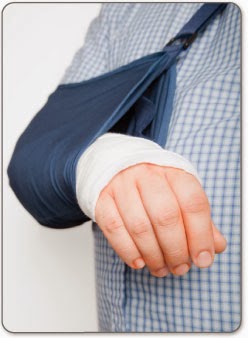 Generally, for arthroscopic and open release surgeries, you will need to wear a sling, brace or cast for at least a week after surgery, or until your first follow-up appointment with the surgeon. For surgeries in the arm or shoulder (and maybe foot) you will be advised by your physician not to drive or operate a motorized vehicle for at least a week after your surgery. This is because restriction of movement will directly affect your ability to steer your vehicle (or brake), particularly in an emergency situation which may require rapid, deliberate movements of the troubled joint.
In order to reduce pain, swelling and inflammation your doctor will prescribe an anti-inflammatory drug to be taken during the first 4 weeks after your surgery, or for however long it is needed, depending on your pain level. Your surgeon will also recommend elevation and cold compression for reduction of post surgery swelling and inflammation. Rest is also vital to your rehabilitation plan, depending on the surgery you have undergone. When it comes to tendon repair surgery recovery, your surgeon will expect you to rest as needed to prepare for PT and exercise to come. Depending on your type of surgery, rehabilitation appointments at the clinic will begin 2-10 weeks after surgery.
Directly after your surgery has been completed, you will undergo Step 1 of the healing process by stopping the bleeding that has started because of the incisions and work done on your body. Depending on the type of procedure you have just had, your tissue may be sutured together, reconstructed or removed to fix your underlying condition. In any case, as with any injury to your tissue, soft tissue in the immediate area will be bleeding again. Depending on the type of injury you have, your surgeon may even stimulate bleeding during your surgery to trigger the healing process.
Each injury/condition will have different challenges for you after surgery. Your surgeon and/or doctor will provide you with clear direction on how to protect your wound and dealing with pain and your comfort level.
Typically your body will have begun to stop the bleeding as soon as your surgeon has completed your surgery. This means that the veins carrying your blood will close off, and your blood will coagulate (condense to seal the bleeding off) in order to reduce the amount of blood loss in your body. Your body knows to do this automatically because blood is so vital to the healing process. Blood is basically the vehicle for oxygen and nutrients that travel directly to the injury deep down in the body - where these things are needed most.
In order to reduce pain, swelling and inflammation your doctor will prescribe an anti-inflammatory drug to be taken during the first week after your surgery, or for however long it is needed, depending on your pain level. Your surgeon will also recommend the use of a Cold Compress or Ice Pack on a frequent basis - multiple times per day - to control your inflammation and reduce your pain.
If you have undergone an arthroscopic surgery, you may have less blood loss and your doctor or surgeon will check before you leave the hospital to make sure your bleeding at the incisions has stopped. If you have undergone open tendon surgery, your doctor and/or surgeon will check your incisions periodically over the next few days of your hospital-stay to ensure that your body has stopped the bleeding on its own and also make sure that your incisions are starting to heal.
Movements to Watch Out For After Surgery
Depending on the joint that was operated on, you may be advised by your physician NOT to drive or operate a motorized vehicle for at least a week after your surgery. This is because you will have still have limited range of motion. However, for elbow or shoulder surgery, you are probably finding it difficult - if not impossible - to drive anyway... so this shouldn't surprise you.
Right after surgery, avoid straining the joint that was just operated on.
Do not lift heavy objects and try not put any strain on the joint for four to six weeks following surgery - this may include using a keyboard / mouse, mobile phone, climbing stairs, and even dressing.
Sleeping may provide a challenge for quite a few people. For elbow or shoulder surgery, try putting a towel roll under your elbow to support your arm. Adding an incline wedge to your bed may be more comfortable than lying flat.
For sleeping after knee surgery, it is recommended to:*
- Sleep on your back (not your stomach)
- When sleeping on memory foam, use a pillow or foam wedge under your knee
- Don't sleep on your stomach
- If you sleep on your side, sleep on the side that was not operated on with a pillow or two between your legs to keep your recovering knee stable
- A recliner or zero gravity chair will provide good knee support & promote good blood circulation while keeping your knee stable.
(*Ellis, N., Ellis, S., Ellis, Nicky et al. "The 3 Best Sleeping Positions After Knee Arthroscopy." We Sleep Well. N. p., 2018. Web. 19 Oct. 2018.)
For sleeping after hip surgery, it is recommended to:*
- Sleep on a firm bed or mattress.
- Use a pillow between your knees
- Don't sleep on your stomach
- Don't sleep with pillows beneath your knees
(*"Sleeping After Hip Surgery | Cleveland Clinic." Cleveland Clinic. N. p., 2018. Web. 19 Oct. 2018.)
Your surgeon may instruct you to wear a sling/cast/brace/walker at all times for 4 to 6 weeks. The length of time needed will depend on the type of surgery you have had. You may remove the sling/brace/cast for exercise as prescribed by the surgeon or therapist, icing, dressing and showering. Normal daily activities around the house and/or work activity may be considered acceptable as long as you wear the sling/brace/cast.
After your incisions and repaired/removed soft tissue have stopped bleeding, the area will probably be tender, swollen, red and hot to the touch - these are all symptoms of inflammation. Step 2 of the healing process is inflammation reduction. At this point you will be home if you have had arthroscopic surgery, or you may still be in the hospital if you have had open surgery. In order to reduce pain, swelling and inflammation your doctor will prescribe an anti-inflammatory drug to be taken during the first week or 2 after your surgery. Your surgeon will also recommend a cooling treatment protocol, like R.I.C.E. (Rest, Ice, Compression, Elevation).
Rest at this point is vital to your rehabilitation plan depending on the surgery you have undergone. If you have had arthroscopic surgery with minimal internal wounding from your surgeon, you may be encouraged to start movement early or as soon as possible. Limited movements of the joint will be required in most cases after the surgery. If you have had an invasive open surgery, then you may be encouraged to rest longer at first before starting movement.
Your doctor or surgeon will advance you to the next Phase of rehabilitation when there is no evidence of inflammation or swelling in the joint. If you have had arthroscopic surgery, your doctor may expect that you are able to move your joint around pain free before moving onto the next Phase of rehabilitation.
Post-OP Phase 2: Gain Back Range of Motion (ROM) and Stability
After the initial healing from your surgery, your soft tissue will be in a weakened state and will not be as strong as healthy tissue for some time. This is why you need to be on "re-injury watch" and make the most of your home treatments and PT appointments during your rehabilitation. It would be devastating if overdoing it at any point during the first few weeks or months of rehabilitation, would send you right back into the operating room.
When Step 1 and 2 is done (phase 1 complete), temporary tissue will start to grow around soft tissue that was damaged during your injury or the surgery. Step 3 is the Growth of Temporary Tissue.
Once your new tissue has begun to grow you will be encouraged to gain back some of your range of motion (ROM) and increase the stability of your joint. Your doctor or surgeon may also introduce regular PT appointments. You may still be expected to wear a sling/cast/brace to reduce the amount of stress you are placing on your joint during movement (reducing your risk of re-injury).
You will start gradual movement of your joint in a free (non-forced) way with very low impact exercises, normally with very few repetitions of activity. Your joint may be stiff at first, and you should expect simple and easy movement to be a bit more difficult for you to master and painful. Exercise of any kind is a method of increasing blood-flow in your joint to increase the amount of oxygen and nutrients that travel to your injured tissue.
You might start with gentle active limb extensions and flexion exercises with a hard brace/cast on at 0 - 14 days. In weeks 2 & 3, when you're out of a hard brace, pain is the guiding factor with tolerance of weight-bearing for any exercises.
Strengthening exercises will slowly increase in difficulty (with more resistance) around 3 - 8 weeks after your surgery.
If your surgery involved tendon repair, at about 6 to 12 weeks (depending on your type of surgery) you still need to allow for healing from the surgery. Although you may be feeling much better and your pain is reducing, your joint at 4 weeks will typically be healed less than %30. At 8 weeks it will be about 40% strong and after 12 weeks the tendon is 60% as strong as normal tendon. The point where the pain decreases yet the tendons are still weak is a critical point. This is the stage where you need to be very careful about re-injury.
Your surgeon will recommend regular PT appointments in the first 6 weeks after surgery. The type of surgery and the degree of damage to your joint will also make a difference in how soon you start PT.
Your PT appointments will be 1-3 times per week, and your progression of movement in your joint will be the guide. At your appointments you will be encouraged to gain back some of your range of motion and increase the stability of your injured joint. You will start with the gradual movement of your joint in a free (non-forced) way with little weight or resistance, normally with very few repetitions of activity. Your joint will be stiff and painful at first, and simple movements may seem challenging in the beginning. Don't be discouraged, your hard work will payoff in the end!
At Home Stretching/Exercise - Your therapist will encourage you, telling you just how important it is to commit to regular exercise at home as well as in the clinic. You should be doing homes exercises up to 3 times per day. They will give you the exercises and guidance based on your overall soreness level and your morning discomfort.
We advise that you apply a TShellz Wrap® treatment to help increase your blood flow before stretching (or exercise). Apply a TShellz Wrap® treatment for approximately 15 minutes (finishing 15 minutes before exercise) to help increase elasticity and flexibility of tissue in the treatment area. The increased elasticity is intended to help minimize tissue tears and scar tissue growth (increase ROM and decrease re-injury risk.

Controlling post-exercise swelling and inflammation is crucial during this Phase. Any sign of swelling or inflammation after exercise may be an indication of minor re-injury to soft tissue in the joint. Control your inflammation immediately after exercise with a 15 to 20 minute cold treatment. If you are not careful to treat your swelling or inflammation immediately after exercise you may experience a set-back in your recovery.
Your doctor, surgeon or physical therapist will advance you to the next Phase of rehabilitation when you show measured improvement of range of motion (ROM), strength, stability and flexibility of your joint. The level of improvement will depend on the severity of your injury and the type of surgery you have had. For example, if you have had a relatively simple arthroscopic repair of tissue, you may be expected to move the joint around before moving to Phase 3 of your rehabilitation.
If you have questions, call our office at 1-866-237-9608 (toll free continental US).
Post-OP Phase 3:
Gain Back Full Capability of Your Joint
At this point, temporary tissue will go through different stages of conversion into healthy, normal, flexible tissue. This is Step 4 of the healing process. Before converting into healthy tissue, temporary tissue will often become tough, dense, fibrous scar tissue. Scar tissue has an unorganized, inflexible tissue structure, which makes it brittle. Scar tissue will provide your injury with more long term fusing power, but will also stick to surrounding healthy tissue. Scar tissue is what stiffens your joint, restricting movement and flexibility.
This phase of your rehabilitation will focus on an increase in activity level in order to regain full range of motion (ROM) and muscle strength in your arm. Your doctor or PTt will increase your activity by introducing the regular use of a rowing machine, weight press or pull-down machines.
Use a TShellz Wrap® (Circulatory Boost) BEFORE workouts and a Cold Compress or Ice Pack after work-outs. This protocol will go a long way to maintaining overall tissue stretchability, reduce re-injury risk, and treat any pain, swelling or inflammation due to overexertion of the joint.
Your doctor or physical therapist will advance you to the next Phase of rehabilitation when you have regained full ROM (range of motion) without pain in your joint. You may also have to pass clinical exams or tests of your muscle strength, balance, stability and flexibility in order to be cleared for Phase 4.
Post-OP Phase 4: Return to Regular Use & Activity
Depending on your job (and whether your occupation has contributed to causing your condition), you may be able to return back to work from within 6 to 12 weeks after the surgery. Overall healing of the joint after surgery may take upwards of 6 to 12 months, which means you may not be able to return to sports or do heavy, forceful activities until a year has passed after your surgery.
In many cases, your doctor or surgeon may recommend that you continue muscle strengthening and stretching instructed during your rehabilitation in order to maintain healthy ROM. Additional cardiovascular exercise will also be encouraged. If you are an athlete or have a job that requires extensive physical capability, your doctor or physical therapist will likely advise a very gradual return to previous activity. They also may encourage continued rehabilitation and/or maintenance of your joint through PT or conservative treatment methods, to prevent re-injury.
Scar tissue may plague you for weeks, months and maybe even years after your surgery depending on your level of activity and the amount of conservative treatments you have undergone during your rehabilitation. Scar tissue will be a major problem as scar tissue can easily build up quickly and its hard to get rid of.
Even if you have been cleared to get back to activity, you still must be careful with the activity you take on. You need to keep in mind that your joint won't be back to 100% for some time (if at all). Continued stretching with the exercises and stretches outlined by your PT, treatment with T•Shellz and cold treatments will maintain good health in the area and significantly reduce your risk of re-injury.
Your success to recovering from tendon surgery is largely up to you:
Dealing with Scar Tissue After Surgery
How Scar Tissue Affects Your Rehabilitation
Tendons, ligaments, muscle and other soft tissue in the joint are all meant to be soft and flexible, ready to work and move small to extreme forces in everyday activities. When I say extreme force, I mean try to imagine the amount of tension that is put on your ankles, hips and knees when running or climbing stairs - even when you are just walking even, let alone running. Shoulders and elbows often deal with heavy or repetitive forces at work if you are a tradesman, garden or work in an assembly line. Try to imagine the amount of force that your arm puts on your elbow and shoulder when you are just trying to throw a football or lift something heavy.
Scar tissue grows in damaged tissue when it tries to heal; little tiny band-aids that overlap each other to bind tiny tissue tears together. With this added scar tissue, muscles & tendons & ligaments become rigid, less flexible and unable to handle the forces that it once could. If scar tissue is found in a tendon or muscle, this can impede joint movement and/or cause pressure points - increasing the risk of further soft tissue injuries and inflammation. If you're suffering with scar tissue now you may feel the effects with stiffness, tightness, weakness and tiredness in your joint and muscles.
Scar tissue can form fast to bring together the edges of a tear, but working fast doesn't mean that the job's done right. When scar tissue forms it doesn't come together as neatly as regular (healthy) tissue would. Scar tissue fibers will lay down over top of your tear in a cluttered, messy and jumbled up way.
On-going issues with scar tissue can result in soft tissue tears and increase chances of strain to nearby tendons or ligaments (as they are now handling higher forces due to overcompensation).
Scar tissue is one of the MAIN reasons why a chronic soft tissue injury has not healed and your Range of Motion (ROM) is reduced from what it once was.
Scar tissue will form fast to deal with a soft tissue injury, and this scar tissue will attach to EVERYTHING in the area, including the surrounding healthy tissue as well. This can result in a fusing together of soft tissue that shouldn't be fused together (muscles,tendons,ligaments), and this will cause extreme pain when you move your leg - it is literally ripping scar tissue. This is why PT is often painful - the therapist stretches the joint, forcing the scar tissue bonds to break so you can regain your range of motion.
Scar tissue can become a major problem and cause your injury to become chronic - taking months or even YEARS to completely heal!
Scar tissue is something that will be present in and around your tendons and muscles before and after your surgery. The growth of scar tissue is ultimately what causes stiffening in the joint, restricting movement and flexibility. Scar Tissue is something that cannot be avoided during surgery. Your surgeon will determine if the anticipated outcome from surgery will be successful, despite the buildup of scar tissue that you will develop as a result of the surgery. Overall, the surgeon may be able to remove a lot of the initial buildup of scar tissue around the injury and in doing so, view a positive outcome from the surgery.
Unfortunately, scar tissue may plague you for weeks, months and maybe even years after your surgery, depending on your level of activity and the amount of conservative treatments you have done during your rehabilitation. Scar tissue is a major problem, especially when it comes to re-injury risk. When dealing with scar tissue it is always important to:
- listen well to your physician, and remember to stick to your conservative treatment plan. Using these treatments every single day will help minimize the amount of scar tissue that will grow in the wound.
- know that frequent use of a
Cold Compress or Ice Pack after surgery will help reduce the swelling very quickly. Most of the pain you usually feel will be from the swelling, and you'll be surprised how fast pain drops once the swelling is down. Scar tissue growth is further inhibited by a reduction in inflammation (swollen tissue prevents blood flow - tissues die without blood and scar tissue grows in its place)
- know that the
TShellz Wrap will help reduce scar tissue and increase blood flow to the area (thereby accelerating the body's own healing process). Treating yourself with this device after surgery (when your doctor gives the ok) is probably the easiest and most effective way to effectively catalyze your body's healing capability.
- use the
TShellz Wrap before physical activity.
Circulatory Boost treatments increase flexibility and elasticity of soft tissue, improve range of motion (ROM), reduce stiffness and tightness and reduce the chance of tissue strain during activity.
Scar tissue is something that needs to be dealt with fast. If you try to get back into your regular daily activities after surgery with a mound of scar tissue in your joint you'll have a higher risk of re-injury and also overcompensation injuries. Scar tissue is just not built to withstand the pressures of regular activity.
If you have an injured tendon with a lot of scar tissue and re-injure that tissue, even more scar tissue will grow to fill in those tears. If you keep falling into the dangerous cycle of re-injuring your tendon without proper treatment you could end up with massive amounts of scar tissue in your joint. Your ability to move your affected joint in a normal way will be impaired as the amount of scar tissue increases.
The only solution to truly recover from invasive surgery for good is to break up scar tissue and avoid re-injury.
This can be achieved through regular use of the TShellz Wrap® accompanied with a stretching/exercise plan assigned by your PT. A light consistent stretch regimen will help break down scar tissue and improve flexibility during your post-op recovery.

Expectations for Long-term Recovery
Rehabilitation after tendon surgery is just the beginning of your recovery process. Even after you've had surgery to fix the problem and deal with the build-up of scar tissue, it is improbable that your soft tissue will heal 100%. From this point forward, it is more important than ever to be careful with the joint that was recently operated on. The joint is probably weaker now, and your risk of re-injury is much higher.
Manage Your Symptoms On A Daily Basis To Prevent Re-Injury
It's simple to manage long-term healing from surgery with conservative treatment methods that can be used in the comfort of your own home. If you're looking for an all-natural form of pain management and long-term healing solution for long-lasting relief, seriously consider the benefits of incorporating the TShellz Wrap® into your treatment plan.
A Cold Compress or Ice Pack can help you to decrease post-operative pain and swelling while also managing any pain from occasional inflammatory flare-ups (re-injury).
During your last few stages of rehabilitation, while you're undergoing PT and focusing on improvements to your range of motion, it's important to maintain healthy blood flow in the area. Strong and healthy soft tissue need a solid local circulatory system, and this is exactly what our TShellz Wraps® are intended for.
Reduced blood flow slows down your recovery process. If your tissue remains in this condition, you'll always be at risk of re-injury that will severely set back your healing progress.
Use TShellz Wraps® regularly to prevent re-injury and keep your muscles, tendons and ligaments elastic and flexible. Healthy blood flow is vital to the healing process after surgery. Your blood flow is what brings oxygen, nutrients and energy (things needed to heal) into damaged soft tissue. Blood flow promotes tissue re-growth, strengthening the delicate work your surgeon has done.
Regular treatments with Circulation Boost via the TShellz Wrap will help you increase blood flow for up to 4 hours with just one 20 minute application! In our opinion, there simply isn't a better product on the market available for use at home to boost localized blood flow while increasing the length and elasticity of tissue so it is less likely to re=injure.
Improve Circulation & Reduce Re-Injury Risk with the TShellz Wrap®
When to use a TShellz Wrap®:
- Once the swelling is gone (usually after applying cold compression to the injury over 24 to 72 hr period).
- BEFORE getting out of bed in the morning. BEFORE going to bed at night.
- BEFORE exercise, workouts or activity of any kind to increase elasticity of tendons, ligaments and muscles and decrease the chance of re-injury.
- AFTER surgery (once the skin wound has healed over) to boost blood circulation, helping surgically repaired tissues rebuild for long-term health and minimize scar tissue growth at the surgery location.
- Anytime BEFORE you feel you might undertake activity that will put significant strain on the injury area.
When to use a Cold Compress or Ice Pack:
- 24 to 72 hours after your initial injury or when you first notice pain and swelling to stop tissue damage at the microscopic level, relieve pain, and decrease swelling.
- After exercise, workouts or activity of any kind to prevent re-injury.
- Before and after surgery during rehabilitation to control pre and post-surgery pain and swelling.
- Anytime you feel your joint has been over-extended, over-worked, twisted, strained or sprained causing pain and swelling.
- Anytime you have swelling, sharp throbbing pain or inflammation.
- Any other situation where you need to draw the pain and inflammation out of the area.
Are You Dealing with Rehabilitation After Tendon Surgery?
We Have Answers that can Help...
Most cases of chronic tendon injuries will respond quite well to dedicated, conservative treatment protocols, however, surgery will be needed in some cases. Undergoing tendon surgery can be a scary and challenging time for most.
The Internet and any medical professionals available to you (your surgeon, orthopaedic specialist and/or physical therapist) will provide a wealth of information and details on the surgery itself, but it can be a challenge to fully understand the medical terminology used, how your body reacts to the surgery and what comprehensive rehabilitation plan will get your body healed as soon as possible.
Surgery in itself is not the end of the journey, it is merely
the beginning of a new chapter. Your rehabilitation efforts will have an important impact on how soon you can return to living and enjoying your normal daily life.
It truly takes a cohesive rehab plan after surgery - incorporating conservative treatments, rest and PT/exercise - to ensure a complete recovery takes hold. There is no single answer and each individual experience in rehabilitation is different.
We here at AidYourTendon provide suggestions and options for people to help get them through this life changing event. We assist many people in shaping an individual course of action to help them heal after surgery.
Click HERE to Go To Our Online Store If you have questions, call our office at 1-866-237-9608 (toll free continental US).
The Next Step Is Up To You!
Living with pain is never easy as it affects your entire lifestyle. Living with pain during or after intensive surgery with a lengthy rehabilitation period can be even harder! What is more important than making the proper decision when it comes to dealing with your tendon and joint pain after surgery?.
 Doctors and Surgeons are always improving the technologies used in surgery, and results from surgery now are much more positive than they were in the past. However, all surgeries introduce scar tissue, and full recovery from surgery is often less successful than you might expect. If you do wind up getting surgery, know that rehabilitation at-home while attending regular PT or doctor appointments is vital for your overall recovery. It is especially vital to joints that consistently handle extreme forces. Consistent exercise and conservative treatment on a daily basis during your rehabilitation while working with your doctor, surgeon or physical therapist is key - and this is why you should seriously consider maximizing your recovery at home by using the TShellz Wrap® once you are approved for PT.
AidYourTendon stands out in this regard as our goal is to help you recover 100% for the long term during your post-operative rehabilitation and beyond.
We strongly believe that we can help you, and we have thousands of happy clients to back this claim. You are welcome to try our products for a 60 day period.. If you are committed to following the treatments outlined in the product instructions we are very confident that our TShellz Wraps will aid you immensely. If you do not receive the benefits that countless of our other customers have experienced from our products, call us, mail the product back to us and we will provide you with a full product refund.

Our online shop accepts Visa & Mastercard as well as a Paypal Payment option.
We also encourage your to Call Our Office at 1-866-237-9608 (toll free continental NA) where we can answer any questions you have and/or take your order via phone.
The bottom line is, you are welcome to try our products for a full 2 months. If you do not receive the benefits that others have experienced, simply call us, then return your purchase back to us and we will issue a prompt & full refund. There will be no hard feelings.
Product Advisors are available 9:00 am to 5:00 pm Eastern Standard Time Monday to Friday.
Learn More About Tendon Injuries & TreatmentsI want to learn more about Post-Surgery Recovery I want to learn more about TShellz Wrap® Circulatory Boost I want to learn more about Ice & Heat: Which Is Better For Treatment? I want to learn more about Tendonitis Treatments I want to learn more about Tendonitis Surgery
FREE SHIPPING ON ALL PRODUCTS CURRENTLY ENABLED
60 DAY TRIAL PERIOD
During your recovery, you will probably have to modify and/or eliminate any activities that cause pain or discomfort at the location of your soft tissue injury until the pain and inflammation settle. The more diligent you are with your treatment and rehabilitation, the faster you will see successful results!
| 
